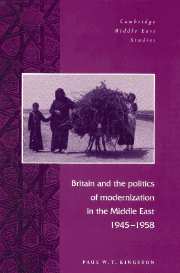Book contents
- Frontmatter
- Contents
- Acknowledgements
- Introduction
- 1 Britain, peasants, and pashas: debating approaches to modernization in the postwar Middle East
- 2 Imperial dreams and delusions: the economics of promoting Middle East modernization
- 3 The British Middle East Office and the abandonment of imperial approaches to modernization
- 4 The British Middle East Office and the politics of modernization in Iran, 1945 to 1951
- 5 The British Middle East Office and the politics of modernization in Iraq, 1945 to 1958
- 6 The British Middle East Office and the politics of modernization in Jordan, 1951 to 1958
- Conclusion: ‘hastening slowly’
- Notes
- Bibliography
- Index
5 - The British Middle East Office and the politics of modernization in Iraq, 1945 to 1958
Published online by Cambridge University Press: 09 October 2009
- Frontmatter
- Contents
- Acknowledgements
- Introduction
- 1 Britain, peasants, and pashas: debating approaches to modernization in the postwar Middle East
- 2 Imperial dreams and delusions: the economics of promoting Middle East modernization
- 3 The British Middle East Office and the abandonment of imperial approaches to modernization
- 4 The British Middle East Office and the politics of modernization in Iran, 1945 to 1951
- 5 The British Middle East Office and the politics of modernization in Iraq, 1945 to 1958
- 6 The British Middle East Office and the politics of modernization in Jordan, 1951 to 1958
- Conclusion: ‘hastening slowly’
- Notes
- Bibliography
- Index
Summary
Iraq's modern history has revolved around attempts to integrate a diverse and fragmented country. Before its creation in 1921, Iraq had been a peripheral outpost of the Ottoman Empire consisting of three loosely administered vilayets each with its own distinct geographic, ethnic, and religious features. To a great extent, the desert ruled over the sown and the tribe ruled over the state. The integrating potential of the two great rivers of Iraq – the Tigris and Euphrates – that had once formed the basis of great civilizations in the past had been long neglected.
However, in the late nineteenth and early twentieth century, two factors emerged to push what was to become Iraq into the modern world of nation-states. The first was the implementation of the tanzimat reform programme designed to transform the loosely knit Ottoman Empire into a more efficient and centralized state. Aided by the penetration of European capital which served to integrate what had previously been a subsistence agricultural economy into the world markets, this had the dual effect of encouraging the settlement of the nomadic population while weakening the tribal fabric of society, all of which enhanced attempts by the Ottoman authorities in the nineteenth century to redress the imbalance of power between state and society.
The second major development was the destruction of the Ottoman Empire and its replacement in Iraq with the British mandate in 1921. Iraq was given all the trappings of a modern state: boundaries, a constitution, a monarchy, a bicameral legislature, an administration staffed with British advisers, and a security apparatus.
- Type
- Chapter
- Information
- Publisher: Cambridge University PressPrint publication year: 1996
- 1
- Cited by



